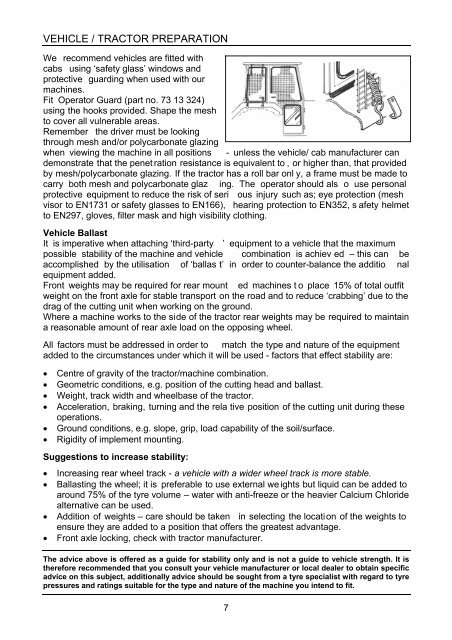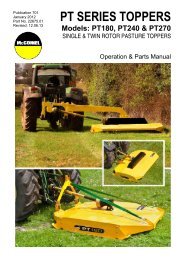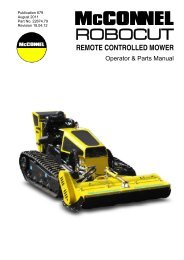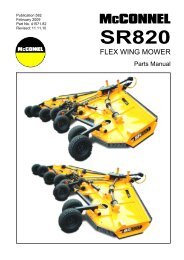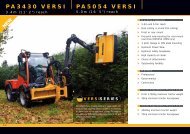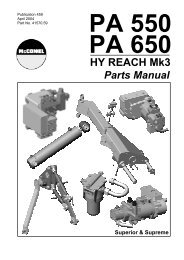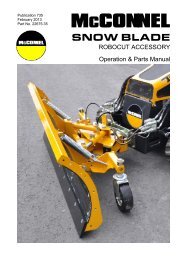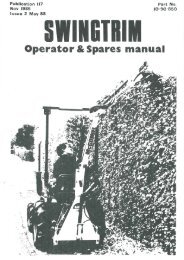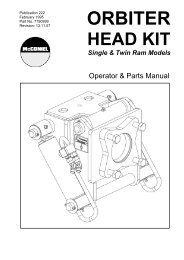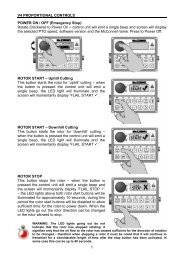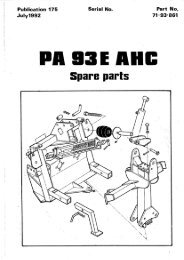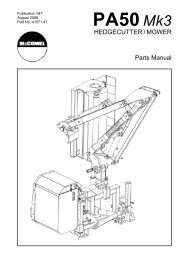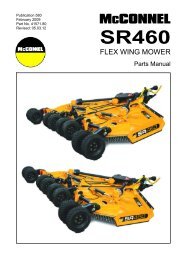FLAIL MOWERS PRE-OPERATION Inspection - McConnel
FLAIL MOWERS PRE-OPERATION Inspection - McConnel
FLAIL MOWERS PRE-OPERATION Inspection - McConnel
You also want an ePaper? Increase the reach of your titles
YUMPU automatically turns print PDFs into web optimized ePapers that Google loves.
VEHICLE / TRACTOR <strong>PRE</strong>PARATION<br />
We recommend vehicles are fitted with<br />
cabs using ‘safety glass’ windows and<br />
protective guarding when used with our<br />
machines.<br />
Fit Operator Guard (part no. 73 13 324)<br />
using the hooks provided. Shape the mesh<br />
to cover all vulnerable areas.<br />
Remember the driver must be looking<br />
through mesh and/or polycarbonate glazing<br />
when viewing the machine in all positions - unless the vehicle/ cab manufacturer can<br />
demonstrate that the penet ration resistance is equivalent to , or higher than, that provided<br />
by mesh/polycarbonate glazing. If the tractor has a roll bar onl y, a frame must be made to<br />
carry both mesh and polycarbonate glaz ing. The operator should als o use personal<br />
protective equipment to reduce the risk of seri ous injury such as; eye protection (mesh<br />
visor to EN1731 or safety glasses to EN166), hearing protection to EN352, s afety helmet<br />
to EN297, gloves, filter mask and high visibility clothing.<br />
Vehicle Ballast<br />
It is imperative when attaching ‘third-party ’ equipment to a vehicle that the maximum<br />
possible stability of the machine and vehicle combination is achiev ed – this can be<br />
accomplished by the utilisation of ‘ballas t’ in order to counter-balance the additio nal<br />
equipment added.<br />
Front weights may be required for rear mount ed machines t o place 15% of total outfit<br />
weight on the front axle for stable transport on the road and to reduce ‘crabbing’ due to the<br />
drag of the cutting unit when working on the ground.<br />
Where a machine works to the side of the tractor rear weights may be required to maintain<br />
a reasonable amount of rear axle load on the opposing wheel.<br />
All factors must be addressed in order to match the type and nature of the equipment<br />
added to the circumstances under which it will be used - factors that effect stability are:<br />
• Centre of gravity of the tractor/machine combination.<br />
• Geometric conditions, e.g. position of the cutting head and ballast.<br />
• Weight, track width and wheelbase of the tractor.<br />
• Acceleration, braking, turning and the rela tive position of the cutting unit during these<br />
operations.<br />
• Ground conditions, e.g. slope, grip, load capability of the soil/surface.<br />
• Rigidity of implement mounting.<br />
Suggestions to increase stability:<br />
• Increasing rear wheel track - a vehicle with a wider wheel track is more stable.<br />
• Ballasting the wheel; it is preferable to use external we ights but liquid can be added to<br />
around 75% of the tyre volume – water with anti-freeze or the heavier Calcium Chloride<br />
alternative can be used.<br />
• Addition of weights – care should be taken in selecting the location of the weights to<br />
ensure they are added to a position that offers the greatest advantage.<br />
• Front axle locking, check with tractor manufacturer.<br />
The advice above is offered as a guide for stability only and is not a guide to vehicle strength. It is<br />
therefore recommended that you consult your vehicle manufacturer or local dealer to obtain specific<br />
advice on this subject, additionally advice should be sought from a tyre specialist with regard to tyre<br />
pressures and ratings suitable for the type and nature of the machine you intend to fit.<br />
7


